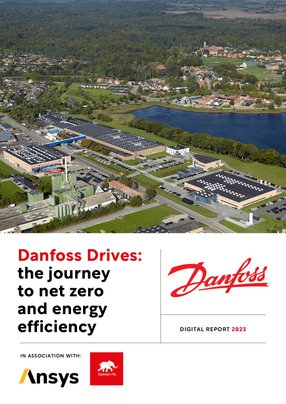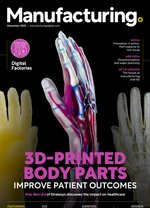Danfoss Drives: journey to net zero & energy efficiency
Danfoss Drives is a member of Danfoss Group, a Danish family-owned company, with 42,000 employees, sales in more than 100 countries and factories in more than 20. Danfoss Group is a powerhouse in energy efficiency and electrification, with sustainability at the very centre of the company.
“We are present all around the globe, but we are well-known to few,” explains Chief Technology Officer, Janne Kuivalainen. “Our ambition is to become our customer's preferred choice partner in decarbonisation and we want to create long-term value for our stakeholders, customers, employees, shareholders and partners as the global leader in energy efficiency.”
Kuivalainen began working in the hydroelectric power plant business with ABB, where he learned about the merits of dynamic optimisation of energy production and that high reliability and availability are key drivers for success.
“Energy production optimisation started to raise its head in the 1990s, specifically for those companies that owned both power plants and factories consuming the electric energy. They started to look at the dynamic optimisation of electricity production and consumption. This is a reality today with distributed energy production.”
Kuivalainen also explored the early days of the industrial ethernet, before joining Vacon Plc in 2005, which he found to be an exciting journey, with the growth of versatile and dedicated solutions. Kuivalainen was the Global Head of Research and Development, when Vacon was acquired by Danfoss.
Now, the biggest challenge in Kuivalainen’s role is ensuring an effective and efficient working environment, from the CEO’s office to the factory floor.
“We are very aware that we have had great success in working effectively and efficiently across our teams, and with our people, to help all of us understand the business better every day.
“I want to emphasise that next to the leaders, we need top-notch key-knowledge experts who are able to then pick up the right priorities, organise efficiently and be inspirational and motivational to their surroundings.”
So far, Kuivalainen’s proudest achievement has been scaling and organising electrification businesses.
“We have a fast-emerging business in electrification,” he explains. “I set up a dedicated team with a startup mentality in 2019, to make room for specific exploration. The green transition has been gathering momentum in recent years, and following the ambidexterity principles for businesses, our team was able to become a business unit in the beginning of 2023.”
Net zero pathways and software engineering create energy efficiency
Danfoss Group has one of the world's strongest portfolio components for decarbonising the three most emission-intensive sectors: industry, transport and buildings.
Danfoss Group committed to reducing its emissions to 46.2% of the absolute scope of Scope One by 2030, 2019 being the base year. The company has also committed to reducing absolute Scope Three emissions by 15% in the same timeframe.
“We have decided that, to reduce our Scope One and Two to zero by 2030, we must use energy-efficient measures, reuse excess heat from the process and source renewable energy.”
As a last resort, the company will offset its emissions.
Danfoss Group has a three-step approach: Reuse, Reduce and Recirculate, which Kuivalainen views as a method of medicine. The company is introducing the Danfoss circularity framework (Rethink Reduce Recirculate) as an integral part of its new product development. By 2030, Danfoss’ ambition is to apply it to all product development.
According to Kim Fausing, Danfoss President and CEO of Danfoss Group, “A third of the reduction needed in energy-related CO2 emissions this decade according to the IEA Net Zero by 2050 scenario must come from improvements in energy efficiency. The good news is that the solutions are there to improve energy efficiency in all sectors. We don’t need to wait. We need action because the greenest energy is the energy we don’t use.”
It is not about how much new green energy can be produced, but how the company can use the energy it has in a much more efficient way. Danfoss Drives is a part of one very public reference, which is its Project Zero—a public-private partnership in the south of Denmark.
“Since 2007, Project Zero has been able to cut 50% of emissions in the city of Sonderborg. That's a reduction from 700 tonnes to 339 tonnes of CO2, from 2007 to 2020.”
Software engineering in the age of digitalisation, cybersecurity and IoT
Software engineering is not what it used to be. Digitalisation comes with industrial internet connectivity, cybersecurity and data privacy, which is also an important topic in the business environment. Kuivalainen is tasked with working out how to improve and manage this in a sustainable way.
“We have applied DevOps to the embedded systems. The IT industry has been using DevOps in development and integrated operations for quite a while.”
The company has now applied that to the embedded software, which requires hardware-software integration, so that Danfoss Drives can carry out testing seamlessly.
Danfoss Drives has been using solutions offered by its partner, Typhoon HIL, in the hardware-in-the loop (HIL) testing. Continuous integration and delivery requires investments in testing.
“We applied robotic process automation for testing and lifecycle requirements, for example, due to cyber security, which meant that we needed to create an architecture that has these elements built in, so that it's easy to maintain.”
Kuivalainen knows that Danfoss Drives can increase the performance on a continuous basis for years to come.
“If I look back to the product itself, we have decided on more extensive use of modelling and simulation. This depends very much on the different physics like thermal, vibration, and EMC simulations.”
Danfoss Drives can generate the software itself for the product, but also the simulation models needed for digital twins, at the same time, from the same source code.
“We envisioned the benefits to ourselves regarding simulation and modelling-based engineering. It has been great to see how we can use it with our customers now.
“Requirements by both customers and regulators will change regarding embedded software. Cybersecurity and data management requirements and regulation will also continue to develop.”
Kuivalainen anticipates that updates will become more common over the lifecycle of a product and they need to be controlled, safe and secure.
“I see that the best practices of it, for example, the DevOps type of operating model is coming into the development of embedded systems as well. It's a reality for us today.”
Electrification in manufacturing, sustainability and energy
Danfoss Drives electrification solutions can be used across the manufacturing, sustainability and energy sectors. The company has firm ESG targets, ranging from implementing Net Zero to a radical reduction of greenhouse gases.
“We found out there are tools and very much our own products, for this, readily available, which are financially profitable. Financing of companies is becoming increasingly dependent on how well they do on their ESG journey.”
In manufacturing industries, Danfoss Drives brings the solutions in electrification to the site level, enabling tangible savings in decentralised conveyor systems, providing drive solutions for local battery-energy storage systems and advanced drive arrangements.
Danfoss Drives and Ansys collaboration empowers digital transformation
Danfoss Drives’ collaboration with Ansys started over a decade ago. As the leading provider of multiphysics simulation software, Ansys has the engineering expertise and comprehensive solutions needed to help innovators push boundaries by using the predictive power of simulation.
“What we value with Ansys is their responsiveness in tool development,” said Kuivalainen. “Optimisation requires high fidelity modelling and simulation.”
Throughout Danfoss Drives’ digitalisation journey, Kuivalainen noticed a barrier to entry for new users of the high-end simulation tools, which could be difficult to understand. This caused a bottleneck for product development.
But with Ansys simulation solutions, such as Ansys Discovery, users can quickly understand how to use the tools; achieve fast, high-fidelity results; and explore multiphysics and multiple physics scenarios.
“With Ansys, we can democratise the simulation, making it more available, so that customers get the right support to get started.”
With Ansys Discovery, Ansys Mechanical, Ansys Fluent, Ansys Icepack and Ansys SIwave, Danfoss Drives can combine fast, accurate physics simulations that are easy to use, meaning that this digitalisation is democratised. For example, Ansys Discovery features interactive modelling and multiple simulation capabilities, which enable users to answer critical design questions early in the design process. This saves time and effort on prototyping as users can explore hundreds of design concepts virtually in the time it would take to build and test just one physical prototype.
Danfoss Drives is also co-innovating with customers with help of simulation and modelling.
“We started to pivot systems in our own application development centres with a customer facing platform. We have physical locations, where we can go to innovate and develop solutions with our customers.”
Danfoss Drives provided hardware in the loop solutions, which Kuivalainen has found rewarding.
“It has been great to work directly with the customers and look at different optimised systems there. We can see how greatly we can help our customers to speed up productive development and run earlier full-scale virtual testing and performance assessments before they have any physical hardware realised for their product.”
Simulation and digital engineering help to transform business at Danfoss Drives, as the company can start work much earlier with its customers looking to develop their next generation of products or systems.
Simulation and modelling systems support software solutions like Ansys Twin Builder which helps the customers to integrate, no matter what tools they are using.
“Simulation modelling helps customers to build better solutions.”
Danfoss Drives makes this easy for its customers, co-developing tools with customers, reaching out and piloting with the customers to understand their needs and being responsive to change. The simulation and modelling products Danfoss Drives offers to its customers is based on the customers’ needs.
For the next year at Danfoss Drives, Kuivalainen will continue to be more effective in bringing the message to the market of energy savings and opportunities available through the Drives solutions.
“The journey continues, while we look at how we can use the same technologies internally, to drive better quality and productivity,” said Kuivalainen.



